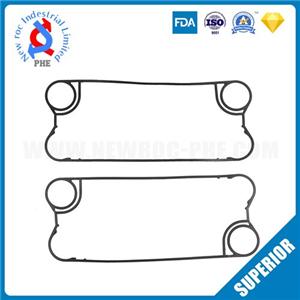Selection of plate heat exchanger materials
Plate heat exchanger plate material 1: 904L, SUS890L stainless steel.
Selection of plate heat exchanger materials
This is a cost-effective austenitic stainless steel that takes into account both price and corrosion resistance. It has good corrosion resistance and is especially suitable for general sulfuric acid, phosphoric acid and other acids and halides (including Cl-, F-). Due to the high content of Cr, Ni and Mo, it has good resistance to stress corrosion, pitting and crevice corrosion. Applicable conditions in chlorinated media.
Plate heat exchanger plate material: 254 SMO high-grade stainless steel.
The ultra-low-carbon high-grade stainless steel modified by increasing the Mo content of Type 316 has excellent resistance to chloride pitting and crevice corrosion, and is suitable for media containing salt water and inorganic acid that cannot be used for Type 316.
Plate heat exchanger plate material: titanium.
Unalloyed titanium, light weight, density 4.51, can naturally form a passivation protective film (Ti2O3), and if it is damaged, it has "self-healing", so it has better corrosion resistance than stainless steel and is suitable for chlorine-containing media (Cl -Typical materials with concentration >200mg/L and temperature ≤130℃). In the seawater and other chlorides (such as CaCl2) solution not exceeding 120℃, it is practically not corroded. Generally, it can be used in seawater below 135°C and various concentrations of salt water (NaCl) below 165°C. Titanium has good corrosion resistance in organic acids below the boiling point (such as concentrated nitric acid, concentrated carbonic acid, etc.) and dilute lye. Titanium has poor corrosion resistance in H2SO4, HCl, HF and aqua regia. In some concentrated chloride solutions at high temperature (above 120°C) (such as wastewater with pH>7 and chloride concentration>200mg/L), crevice corrosion or stress corrosion may also be caused. At this time, titanium-palladium alloy should be used.
Plate heat exchanger plate material: titanium palladium alloy.
This is non-alloyed titanium with palladium (0.12%~0.25%) added, thus significantly improving the corrosion resistance of titanium in acid media (especially in less severe conditions). For example, it has good corrosion resistance to 70% nitric acid, hydrochloric acid containing oxidizing ions (such as Fe+, Cu+), and electroplating solutions. In addition, it can be used for dilute sulfuric acid with a concentration of ≤10% and a temperature of ≤70°C.
Plate heat exchanger plate material five: Nickel 200.
This is a pure nickel plate containing more than 99% nickel. Mainly used for high concentration (50%~70%), high temperature (up to the boiling point) caustic solution (NaOH, KOH, etc.). However, it is very sensitive to crevice corrosion caused by chlorides such as brackish water.
Plate heat exchanger plate material six: Hastelloy C-276.
Has good corrosion resistance: hardly affected by Cl-; excellent corrosion resistance to various concentrations of sulfuric acid, is one of the few materials that can be used for hot concentrated sulfuric acid; widely used in organic acids (such as formic acid, Acetic acid), high temperature HF acid and a certain concentration of hydrochloric acid (<40%), phosphoric acid (≤50%); chlorides, fluorides and organic solvents (such as methanol, ethanol).
Plate heat exchanger plate material seven: Monel 400 Ni (about 70%)-Cu (about 30%) nickel-based alloy.
It has good corrosion resistance in non-gas-filled sulfuric acid with a concentration below 80% and a temperature not higher than 50℃~100℃, HF acid with a concentration below 50% and a temperature below 100℃, acetic acid and caustic alkali. It is especially suitable for acidic chloride solution and brackish water and salt water under certain working conditions; it has good high temperature resistance. But it is not suitable for concentrated sulfuric acid, hydrochloric acid and nitric acid, and it is sensitive to mercury (sometimes present as an impurity) attack.
Plate heat exchanger plate material eight: Incoloy825.
It is suitable for various concentrations of sulfuric acid at low temperatures; it has good corrosion resistance in a caustic alkali (such as NaOH) solution with a concentration of 50% to 70%, and does not produce stress corrosion cracking. However, it is very sensitive to crevice corrosion caused by chloride. In addition, the stamping performance is not very good, so it is not a commonly used material for plates.




